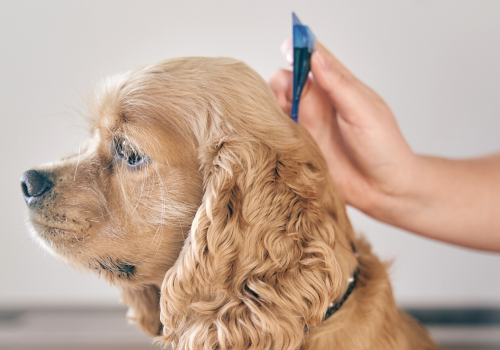We’ve all been there. Your dog is itching an abnormal amount, and you’re not sure if it’s allergies or a dreaded flea and/or tick infestation. None of it is fun, but it’s essential to get to the bottom of it quickly to get your dog some relief. That’s likely why you ended up online and, despite your best intentions, “Dr. Google” is not going to be your most trusted reference. Perhaps you’ve let the preventive medicines lapse, and you’ve noticed what’s called flea dirt on your dog or, worse, you’ve seen what you think is a tick attached to them. Call your veterinarian to get the help you need, but you can also read on for information you can trust. To prevent the misinformation you can find online, we’ve answered frequently asked questions on dog fleas and ticks.
While the information provided by us at Urban Veterinary Associates below is accurate, we’d like to reiterate that it’s always best to talk to your own veterinarian. If your dog needs a veterinarian in or near Westmont, IL, we’d be thrilled to get your dog on the necessary preventative medications. Give us a call at (630) 541-8088 today to schedule an appointment.
How does my dog get fleas and ticks?
Other dogs or pets carry fleas into your home. The places where these fleas have originated are nearly endless, from a neighbor’s home and boarding facilities to dog parks and your local groomers. So if your dog is not protected against fleas and ticks, there are unfortunately many possibilities for them to be able to pick up fleas.
Ticks, on the other hand, start outdoors in tall grasses. So if you live near fields, perhaps on the edge of woods, you’re in an area where you will see ticks, and your dog can pick them up when they run through. You need to be hypervigilant about your flea and tick protection and check your dog for ticks every time they come inside.
Can fleas and ticks spread from my dog to my home and family?
Yes, they can. Fleas like to hitchhike on shoes, clothes, or belongings. It’s also essential to understand the life cycle of fleas in that only one to five percent of the adults are on your dog, and 95% are in your home. Fleas only spend their adult time on the dog. Then, they leave the dog to lay their eggs and have their younger life stages out of the environment. So they certainly can affect you and other pets in your household. Ticks can also get on humans and potentially spread tick-borne diseases.

Can my dog get fleas and ticks if they are primarily an indoor dog?
Yes, they definitely can. This is a common misperception that a pet can't have fleas or ticks if perhaps you live on the second-story floor of an apartment in the city. The dog still needs to go out for walks or, at the very least, to go to the bathroom. We can also bring fleas and ticks into them, and fleas are sometimes found on decks and porches. Also, if you have a cat that goes outside, they can bring fleas into your environment and onto your dog.
What health problems can fleas and ticks cause my dog?
Fleas are notorious for causing severe itching and skin issues in dogs. Some dogs are allergic to flea saliva, so they have an extreme reaction. Fleas also digest your dog's blood, so if there's a bad enough infestation, it can cause anemia and affect your dog’s blood levels. This can be very dangerous, especially in puppies.
Ticks can transmit many different diseases. One of the most well-known tick-borne illnesses is Lyme Disease, which both humans and animals can get.
Tick-borne diseases can cause their own issues, such as:
- The destruction of body cells
- Fever
- Joint issues
- Kidney issues
- And a whole host of other problems
How effective are flea and tick medications, and is there a difference between over-the-counter and prescription?
Flea and tick medications have come a long way in the last 10 years. Back in the day, we used to give flea baths and flea dips. Generally, people don't do that anymore, as we now have preventives, and the ingredients continue to get updated as needed as fleas and ticks start to grow resistance.
We have topical flea and tick preventative medications, which not only kill fleas and ticks but most of them prevent them from jumping on a dog, to begin with. Unfortunately, they’re not always easy to apply, and you have to get it all the way down to the dogs’s skin, just not on their hair coat. That can be quite challenging if you have a very fluffy dog. Also, our dogs sometimes go swimming, and we give them baths, so we are washing the medicine off or making it less potent as the month goes along.
Thankfully, we now have oral tablets, which are essentially chewable treats, and the prevention is good for 30 days but can last for up to eight to 10 to 12 weeks, depending on which ticks you are trying to prevent. The chewable options make it easier for a person to do it themselves. And then, once it's in the dog, we're not worried about whether it got all the way down to the skin and some of those other issues associated with topicals.

What is the difference between over-the-counter and prescription flea and tick medications?
The FDA-approved, EPA-regulated products that you get from your veterinarian work better and haven’t developed the resistance that many of the older, OTC products have. We know a lot more about the preventives we give you and can help you understand when to use them and what to expect as far as the results.
Although there are some topicals and collars available over the counter that are somewhat reputable, the ones we give you are more based in medicine. Also, the non-reputable ones are more similar to how a pesticide might work, so they're not safe. You can always ask your veterinarian which product is best for your dog.
What will my veterinarian recommend for flea and tick treatment?
Your veterinarian will likely recommend a state-of-the-art topical that will also be a preventive, or they're going to suggest an oral preventive. You’ll give the latter once a month or every three months, and we know those will kill fleas within minutes. In some cases, though, the fleas have to bite first. We'll talk about your lifestyle and what will be easiest for you, which often means an all-in-one flea, tick, and heartworm treatment.
How can I identify fleas and ticks on my dog?
You can sometimes see the fleas moving on your dog, but other times you can only see the flea dirt, which is the digestive material of what the fleas ate. You can use a flea comb to find this flea dirt, which often looks like salt and pepper. We know that the dark/pepper part is the excrement of fleas, and the white part that looks like salt is flea eggs. Sometimes owners might think that their dog looks filthy, as though they rolled in the dirt outside, which can also be fleas. If you suspect your dog may have fleas, we highly recommend you get them to a veterinarian as soon as possible. The longer you wait, the worse the infestation of your dog and environment will be.
Ticks in dogs look very similar to ticks in humans. They are tiny, dark brown insects that start to grow as they ingest more blood from your dog. Ticks love to go underneath the armpit and in darker, more vascular areas. If you identify one, call your veterinarian to ensure you're removing it correctly because there can be issues with that, and you want to get the whole body.
What should I do if I see fleas or ticks on my dog?
Call your veterinarian, and as they know your dog's age and your circumstances, they’ll be able to walk you through how to best treat them and what products to use.
The AVMA also offers a comprehensive guide to dog flea and tick prevention. If you have additional questions about preventing or treating fleas or ticks in dogs, we are here to help. As your dog’s veterinarian in Westmont,IL, we would be more than happy to discuss their preventive medications and any other concerns you may have. Call us at (630) 541-8088, or drop us an email at [email protected] today.
